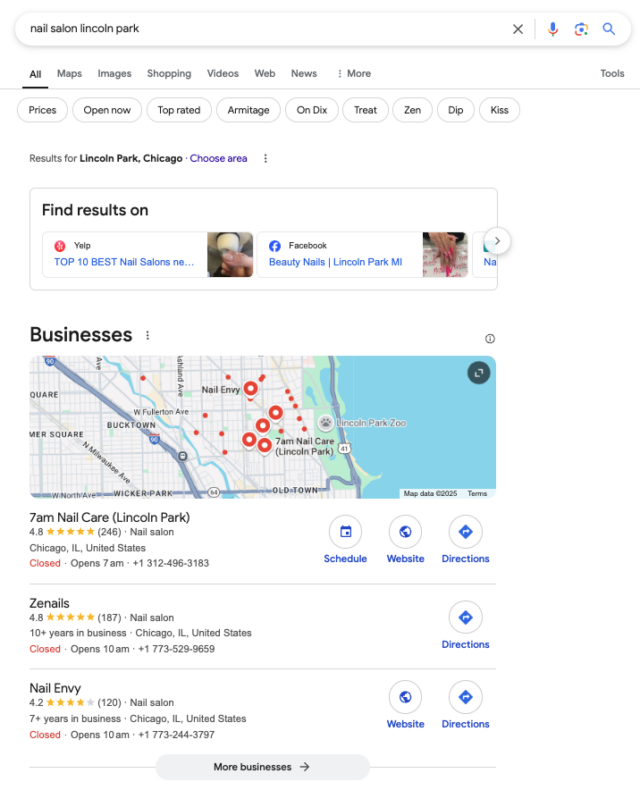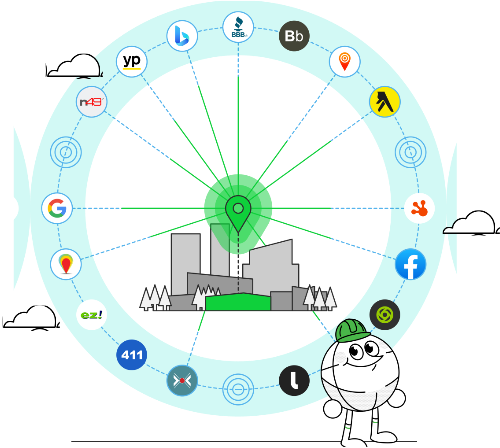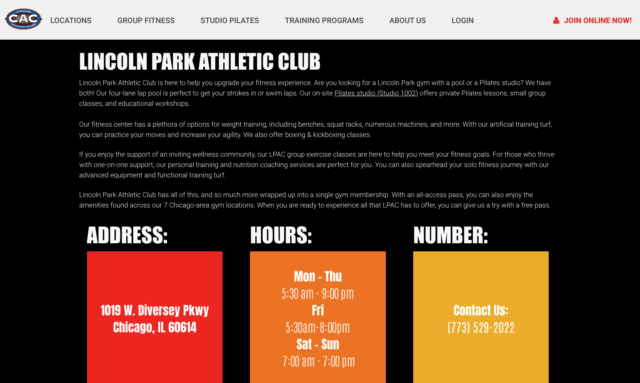
What is Local SEO?
Last updated on February 5th, 2025
Local search engine optimization, or ‘local SEO’ for short, is the work undertaken to improve a local business’s rankings in the local search engine result pages (SERPs).
Essentially, it’s the work done by or for local businesses to ensure they appear in front of potential customers when those customers search for related terms.
If someone searches for ‘best pizza place in Manhattan’, what they’re hoping to find is just that. While many may believe that the results they’re being shown are literally the best, the reality is that the Local Pack uses a special local algorithm to determine which businesses’ Google Business Profiles (GBP) it will show.
Performing local SEO is a concerted effort to tell the local algorithm that your business is one of the ones it should showcase in local search results. It’s not just about leaving it to chance and hoping your quality will bring you out on top.
So it’s as simple as getting a Google Business Profile, adding some geographic keywords to your website, and moving on, right?
If only! There’s a bit (a lot!) more to it than that. Let’s look a little deeper.
How does local SEO work?
So, how do you actually get local SEO to work for you? That’s the big question you’ll have, whether you’re trying to get your single-location coffee shop to rank, or a client’s multi-location laundrette brand. I’m going to help answer the key questions: ‘How do I do local SEO?’ and ‘How does Google’s local algorithm work, and how can I optimize for it?’
Let’s start with that algorithm I keep on mentioning.
What does Google’s local algorithm look at?
Google’s local algorithm (or ‘system’ as Google calls its algorithms) looks at factors that it uses to decide what to show for traditional searches alongside factors that are more specific to local searches.
Google’s local algorithm focuses on three key pillars:
- Relevance: Google assesses how relevant your business is to the search a user has made. It does this by looking at a number of factors, like the category you’ve chosen on your Google Business Profile, other local listings you’ve built, and the description for your business. It also looks at the content your website, among other things.
- Proximity: This is the one that really makes this a truly local algorithm. Google looks at the location of the searcher when they perform the search to try and give them the most useful information, assuming they’re looking for a business nearby.
- Prominence: How well does your business or brand stand out, and how well known is it for the things being searched? A bunch of other businesses will likely be just as relevant and well-located, so in order to present the best results, the algorithm looks at what sets the leading businesses apart. Think reviews, links to your website from reputable sources, mentions in the press, and so on.
With the above in mind, local SEO works by having someone perform a series of tasks that help Google understand that your business is the best one to rank for that search. Some of these tasks are quick, like claiming your GBP and picking your categories, and some need to be consistently performed over a long period of time, like review management or link building.
Read more: Local Search Ranking Factors
Why is local SEO important?
Without local SEO, your business probably won’t be found when someone performs a local search.

For example, if someone in Chicago searches ‘nail salon in lincoln park’ and you’re up against tons of businesses that have hundreds of reviews, a well-maintained GBP and a bunch of well-optimized local landing pages, you’re unlikely to show up. And, if you don’t show up, the chances of someone coming across your business online drastically decrease.
We cover all of this in much more detail in our article on the benefits of local SEO.
If you want an idea, though, the benefits include:
- Better online visibility
- More in-store foot traffic
- Targeted web traffic
- More calls via GBP
- Enhanced trust levels
- More sales
- Improved conversion rate
Read more: What Are the Benefits of Local SEO?
Google themselves put out a key statistic in 2018 that’s still used widely across the industry to help highlight why local SEO is so important: 46% of all search queries have local intent. If that isn’t enough to convince you that it’s worth focusing on your visibility in local search, I don’t know what is. But if you want to see some more local SEO statistics, we’ve got you covered.
Local SEO vs Traditional SEO: What’s the Difference?
The core difference between SEO for local businesses and SEO for other kinds of businesses (such as e-commerce) is in the tasks you’ll need to undertake to improve the local business’s visibility.
Tasks for traditional SEO are aimed at helping a website rank in non-localized searches. Tasks for local SEO are aimed at helping a real-world business rank for a local search.
You’ll notice that I’ve said “business” there rather than a website. That’s because a business can technically rank for local searches on Google without a website, as long as they’ve claimed their Google Business Profile.
Let’s have a look at what a search term with local intent returns in Google compared to a search term without local intent.
Here is a search for ‘car tires’, one that Google sees as a more generic e-commerce search. As you can see, there are a number of Google Shopping options, some paid ads, and then links to websites.

Now take a look at the results of a search for ‘car tires lincoln park chicago’.

As you can see, there’s a stark difference. The local search shows the ‘Local Pack’, which I mentioned previously, and the organic results underneath that are localized, too.
The Local Pack is a box that contains a selection of Google Business Profiles and a map. It’s this section:

That’s very different from a traditional SERP, so it’s logical that the work you need to do isn’t exactly the same.
Traditional SEO tasks include things like:
- Link building and PR
- Technical SEO (although this encompasses a lot of different tasks)
- Content optimization and creation
All of these tasks do form part of any local SEO work, it must be said. So if you’re performing local SEO, then using these as a foundation is a good idea. Content and link building, for instance, just need to be done with a localized slant. Traditional SEO tactics are still important, but they simply become part of a wider tapestry.
So with that in mind, what do you need to consider for local optimization?
What are the key tasks involved in local SEO?
There are a whole host of ways to improve your local rankings. If you’re new to this, though, there are a few simple places you can get started.
- Claim, then optimize, your Google Business Profile
- Do your keyword research
- Look at your competitors
- Build local listings
- Get more reviews
- Create localized content
Use our local SEO checklist for a more exhaustive plan.
Claim, then optimize your Google Business Profile

Do it. Now. Maybe even yesterday if you’ve got access to a time machine. Before you start on anything else, this is a simple first step to take.
Do it here. I’ll be waiting to carry on once you have.
Done that? Great. Need help doing it? We’ve got a guide on claiming your Google Business Profile.
A GBP is how Google understands your business, from the business category you select through to the reviews you get. In addition to that, Google populates the Local Pack with GBPs. Starting to see why it’s so important now?
There’s a lot you need to consider with GBP, so we’ve gone into much more detail in our Google Business Profile Handbook.
Some basic tasks you’ll want to complete once you’ve claimed your GBP include:
- Choosing the right category
- Keeping business information, like opening hours, up to date
- Adding new photos and videos
- Sharing regular Google Posts
- Asking and responding to GBP Q&A
- Requesting and responding to Google reviews
Read more: Google Business Profile Handbook
Work out the keywords you want to rank for
This is the start of any SEO work, whether it’s local or otherwise.
It’s such a big deal that some businesses even include their keywords in their business name. While I wouldn’t necessarily always recommend that, it does highlight that you need to think about how your customers are going to find you as early in the process as possible.
Every SEO expert you talk to will have a different way of recommending performing more detailed keyword research. But a good start is simply searching for your business in the same way that you think your potential customers would, and seeing what comes up in the search results.
Gather a small selection to begin with, and think of the ones with a more transactional intent.
For instance, if you’re a nail salon in Lincoln Park, Chicago:
Nail salon near me
Nail salon in lincoln park
Lincoln park manicure
Best pedicure lincoln park
Other, more “longtail” or informational terms, can come later. For now, you’re just at the beginning of your journey.
There’s a lot more to local keyword research than that, though, so we’ve gone through it in detail as part of another guide in this Handbook.
Read more: Local Keyword Research
As you’ll see when you’re optimizing your GBP, having those keywords handy will be useful. A search below shows how Google pulls the information from each GBP to match the searcher’s query.

Look at your competitors
With these keywords in hand, you can quickly discover who your local competitors are going to be.
Of course, you may just be able to look out of a window, or already have market research in hand. Even so, it’s worth remembering that you may have different competitors in online search.
Once you’ve seen who is ranking for your keywords, you can see how they’re doing it. This gives you an idea of how quickly you can be competitive and where your quicker wins will be.
Are they struggling with reviews on their Google Business Profile? Try to get more than them, and prioritize this activity. Is their GBP a mess? Make yours make more sense. Have they engaged with the local community to get a bunch of links? See if you can do that, too. You get the idea.
One way to check this is simply by Googling. Another is byusing a local SEO tool like BrightLocal’s Local Search Grid.
Read more: Competitor Analysis for Local SEO
Build local listings
While they may not be the one-shot to the top three rankings they used to be, local citations (or business listings) are still an important brick in your local SEO foundation.
Not only does Google use them to assess whether the information they have on you is correct, but they’re also an important way of building trust.
Citations are just as the name suggests: mentions of your business’s important information (Name, Address, Phone Number) on trusted sources. It’s worth investing in a number of key citations to get your foundations in order.

Get Citations Done Fast... and Own Your Listings Forever
No recurring fees. Complete Control. Super-low cost.
Once you’ve built your citations, it’s important that you keep them maintained and accurate.
Why? Well, it’s important that search engines can rely on the business details they scour the web for, but it’s important for consumer trust, too. In fact, The Local Business Discovery & Trust Report 2023 found that 62% of consumers would avoid using a business if they found incorrect information online.
For more of a deep dive into local citations, check out our Local Citations Handbook. If you want to start building your own, we’ve got a lengthy list of business listing sites to help, too.
Read more: Local Citation Handbook
Get more reviews, then actively manage the ones you receive
Review management is a task that falls somewhere between SEO and customer service. While it can benefit both, your online reputation is particularly important for your rankings.

Google has a review functionality in Google Business Profile for a reason: it sees user and customer feedback as a key signal for ranking businesses in local searches.
It’s worthwhile taking time to look into review guidelines for Google and other major platforms. Our Review Management Handbook also has tips on those guidelines and on how to get more reviews.
Read more: Review Management Handbook
Optimize your website for local search
As mentioned above, you technically don’t need a website to rank in local search. But I strongly recommend you have one. Once you get it, you need to make sure it’s designed to help you rank locally.
There are a host of generic on-page SEO tasks you can do to help your local SEO. These includes things like:
- Optimizing meta-data and page titles,
- Implementing local business schema
- Creating an efficient structure for your site
- Making it mobile-friendly (you can use Chrome Lighthouse to check how you’re doing)
- Building relevant internal links
- Providing a positive user experience
Read more: On-page SEO for local
Once you’ve got those basics down, you’ll need to look at your website content.
Mentioning geo-targeted keywords
Think ‘replacement car tires in lincoln park’ or ‘manicure in lincoln park’. If you’re a single location, then this is super easy, as your homepage can do a lot of the heavy lifting. If you’ve got a few locations, or you’re a service area business, then your homepage will be more general, but should still include some important keywords— they may just be city or state-based, rather than borough or small-town based.
Creating location pages
If you have specific business locations all talked about on the same website, then you need to have a way for people to find them. Optimize these location pages for ‘[keyword] in [location]’ as a bare minimum. Then, look at how you can make them truly useful to your potential customers.
We have a more in-depth guide to creating powerful location pages.
Read more: Location Pages
Creating local content
If you’re in a highly competitive market, you can then take this even further. Creating localized content can help increase your overall authority and help Google understand that you’re truly the expert in that area.

The type of local content will vary depending on your niche. But a couple of examples for different niches are below:

Law: If you’re performing local SEO for a law firm, you can consider whether there are any laws in your state or city that are unique. Write a guide to help people understand that. Think ‘Divorce law in Texas’, or something like that, and then how you can write a compelling and informative guide on the subject. If someone is searching for those differences, you want to be the site they find that information on.

Real estate: Similarly, if you’re doing a real estate company’s local SEO you could consider creating area guides that really sell why a specific area is good to move to. Roundups of coffee shops or features on schools in those areas could be a great idea.
This is all just scratching the surface. There’s a lot you can do with your content.
Free Course: How to Create Website Content for Local SEO
Anything else?
That’s just scratching the surface. As I alluded to earlier, building links is something you’ll likely need to consider. The key here, though, will be getting them from relevant local sources.
Other tasks that you may need to consider include:
- Monitoring changes to Google’s algorithm or SERPs
- Fighting spam by reporting businesses that go against Google’s guidelines.
- Engaging with your local community
- Creating social media profiles and actually using them
Tracking Your Work and Reporting Results
Part of any form of optimization process, whether that’s local SEO or your fitness routine at the gym, is taking time to assess how that work is going.
The following are free tools to help you start tracking your results. We have created guides for each to help you set them up and interpret the results.
If you’re taking things seriously, investing in a local rank-tracking tool is also worth it. Geo-grid rank trackers are a great way to visualize how your business is ranking as they show how you’re performing for your keywords based on the search location on a map. There are a few different geo-grid rank trackers available, but we’d recommend our own Local Search Grid.

Put Your Rankings on the Map. Literally.
Track and improve rankings with BrightLocal
What next?
I’ve gone over the basics to help you understand what local SEO is. Hopefully, you’re feeling ready to get started with some of these tasks (or at least know what local SEO services to look for providers of—consider BrightLocal’s if you are!) If you’re still unsure about anything, you’re in the right place—the rest of our local marketing handbooks can help.